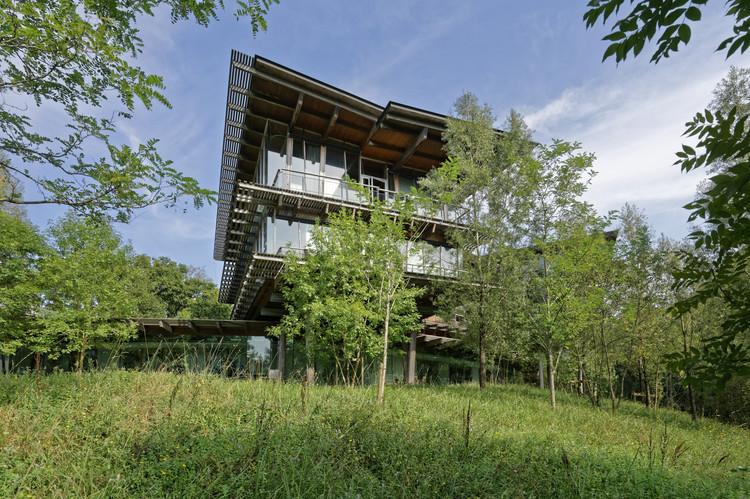Ippudo Sydney Koichi Takada Architects
2013-05-13 01:00
Ippudo旨在将日本面条文化引入澳大利亚餐饮业。伊普多不仅仅是一家餐馆,它是一家展示传统面条碗和勺子的面条文化画廊,也是伊普多诞生地哈卡塔的传统黏土特色墙。员工的热情体现在他们的问候和服务上-所有这些都成为Ippudo餐饮体验的一部分。
Ippudo is designed to introduce the Japanese noodle culture into Australian dining. More than just a restaurant, Ippudo is a gallery of the noodle culture, displaying traditional noodle bowls and spoons, and a traditional clay feature wall from Hakata, the birthplace of Ippudo. The enthusiasm of the staff is reflected in their greetings and service – all becoming part of the Ippudo dining experience.
餐厅的挑战是起伏的木材天花板。它代表了“风的阵风”,意为伊普藤的字面意思。它讲述了这个故事,描述了伊普藤的历史,并让我们深入了解了日本饮食的传统。Ippudo允许你逃跑-这里的气氛很诱人。光线,饰面和木材屏幕创造了纹理和深度。
The challenge of the restaurant was the undulating timber ceiling. It represents the ‘gust of wind’, the literal Japanese meaning of Ippudo. It tells the story; a narrative of Ippudo’s history, and allows an insight into the traditions of Japanese dining. Ippudo allows you to escape – the atmosphere is inviting. The light, finishes and timber screens create texture and depth.
Ippudo以“精心制作的”菜肴而闻名。面条制作过程是体验的一部分,包括关于日常生活和食谱的照片和书籍。这种对细节的细致入微的关注,从食物到内部,在自然完成的应用中可以看到巨大的细节。室内是令人兴奋和自然的-柔和的木材曲线是受欢迎的,整体经验是独特和现代的解释在日本餐厅。
Ippudo is known for the ‘crafted’ dishes. The noodle making process is part of the experience, with photos and books about the routine and recipe. This meticulous attention to detail carries from the food to the interior, where great detail is seen in the application of natural finishes. The interior is exciting and natural – the gentle timber curves are welcoming, the overall experience is a unique and modern interpretation of dining in Japan.
室内设计的驱动因素是包含了Ippudo‘家庭’的激情和完整性,同时创造了一个令人兴奋和永恒的设计。作为澳大利亚第一家伊普多餐厅,该设计旨在创造一个温暖而诱人的室内环境,这不仅提高了就餐体验,还展示了对日本传统餐饮环境的现代诠释。
The driving factor of the interior design was to encompass the passion and integrity of the Ippudo ‘family’, while creating an exciting and timeless design. As the first Ippudo restaurant in Australia, the design seeks to create a warm and inviting interior that not only enhances the dining experience but also displays a modern interpretation of the traditional Japanese dining settings.
弯曲的木材天花板是一个高回报的设计挑战。作为餐厅内部的特色,成品的几何和质量至关重要。木材屏幕剖面设计为一个调制系统,使他们可以预制。每个面板都有一个“灵活的”铝框架,可以在原地弯曲。胶合板肋骨,切割使用数控技术,允许一个平滑的几何形状,每一个面板是弯曲和固定,实现了一个有效的安装过程,也允许最少的浪费。
The curved timber ceiling was a design challenge with high reward. As the feature of the restaurant interior, the geometry and quality of the finished product was paramount. The timber screen profiles were designed as a modulated system, enabling them to be prefabricated. Each panel incorporates a ‘flexible’ aluminium frame, which could be bent in-situ. Plywood ribs, cut using CNC technology, allowed a smooth geometry, to which each panel was curved around and fixed, achieving an efficient installation process, and also allowing minimal wastage.
施工系统保证了每一件都能在建筑物内和彼此之间完美地结合在一起。在青铜面镜的帮助下,效果是一个持续和戏剧性的天花板空间,创造了一个高冲击的内部。餐厅开业以来的持续成功证明了设计的成功和社会的可持续性。
The construction system ensured that each piece fit near perfectly within the building and to each other. With the help of bronze facing mirror, the effect is of a continual and dramatic ceiling space, creating a high impact interior. The continued success since the restaurants opening is proof of successful design and social sustainability.
 举报
举报
别默默的看了,快登录帮我评论一下吧!:)
注册
登录
更多评论
相关文章
-

描边风设计中,最容易犯的8种问题分析
2018年走过了四分之一,LOGO设计趋势也清晰了LOGO设计
-

描边风设计中,最容易犯的8种问题分析
2018年走过了四分之一,LOGO设计趋势也清晰了LOGO设计
-

描边风设计中,最容易犯的8种问题分析
2018年走过了四分之一,LOGO设计趋势也清晰了LOGO设计
.jpg)























.jpg)



.jpg)





























.jpg)







